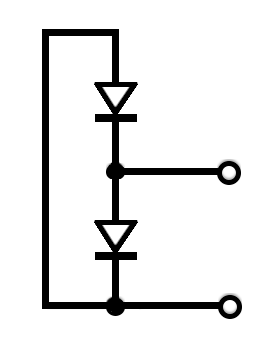Varistor
Varistor is an electronic component that is designed to protect electrical and electronic equipment against high voltage spikes. Its name is derived from the words "variable resistor," which describes its function: the resistance of a varistor changes with the voltage applied across it. Varistors are widely used in various applications to protect against overvoltage conditions, which can damage electronic circuits.
Overview[edit | edit source]
A varistor is a type of resistor with a non-ohmic current-voltage characteristic. The most common type of varistor is the metal-oxide varistor (MOV). These devices are made from a ceramic mass of zinc oxide grains, sandwiched between two metal plates (the electrodes), which act as the electrical contact to the rest of the circuit. The grain boundaries provide the non-linear electrical characteristics that make the varistor useful for overvoltage protection. When a low voltage is applied across the terminals of a varistor, it behaves like an insulator. However, when a high voltage is applied, the varistor's resistance decreases dramatically, allowing it to absorb and dissipate the excess energy as heat.
Applications[edit | edit source]
Varistors are used in a wide range of applications to protect against transient voltage spikes. These include:
- Power supply circuits
- Telecommunication equipment
- Automotive electronics
- Consumer electronics such as TVs, radios, and computers
- Lightning surge protectors
Types of Varistors[edit | edit source]
Besides the commonly used MOV, there are other types of varistors based on their material and construction, including:
- Silicon carbide (SiC) varistors - Used before the MOV became popular, but now largely obsolete due to their lower energy dissipation capabilities.
- Silicon Avalanche Diode (SAD) - A semiconductor device that operates in a similar manner to varistors but is used for lower voltage applications.
Selection Criteria[edit | edit source]
When selecting a varistor for a particular application, several factors must be considered, including:
- Maximum operating voltage
- Energy absorption capability
- Response time
- Operating temperature range
Limitations[edit | edit source]
While varistors are effective for protecting against voltage spikes, they have limitations, including:
- Degradation over time with repeated exposure to surges, leading to a reduced lifespan.
- Potential for catastrophic failure if exposed to voltages beyond their maximum rating, which can result in a short circuit.
Safety Considerations[edit | edit source]
To ensure safe operation, it is important to select a varistor with an appropriate rating for the specific application. Additionally, proper installation and periodic inspection are necessary to detect any signs of degradation or failure.
Search WikiMD
Ad.Tired of being Overweight? Try W8MD's physician weight loss program.
Semaglutide (Ozempic / Wegovy and Tirzepatide (Mounjaro / Zepbound) available.
Advertise on WikiMD
|
WikiMD's Wellness Encyclopedia |
| Let Food Be Thy Medicine Medicine Thy Food - Hippocrates |
Translate this page: - East Asian
中文,
日本,
한국어,
South Asian
हिन्दी,
தமிழ்,
తెలుగు,
Urdu,
ಕನ್ನಡ,
Southeast Asian
Indonesian,
Vietnamese,
Thai,
မြန်မာဘာသာ,
বাংলা
European
español,
Deutsch,
français,
Greek,
português do Brasil,
polski,
română,
русский,
Nederlands,
norsk,
svenska,
suomi,
Italian
Middle Eastern & African
عربى,
Turkish,
Persian,
Hebrew,
Afrikaans,
isiZulu,
Kiswahili,
Other
Bulgarian,
Hungarian,
Czech,
Swedish,
മലയാളം,
मराठी,
ਪੰਜਾਬੀ,
ગુજરાતી,
Portuguese,
Ukrainian
Medical Disclaimer: WikiMD is not a substitute for professional medical advice. The information on WikiMD is provided as an information resource only, may be incorrect, outdated or misleading, and is not to be used or relied on for any diagnostic or treatment purposes. Please consult your health care provider before making any healthcare decisions or for guidance about a specific medical condition. WikiMD expressly disclaims responsibility, and shall have no liability, for any damages, loss, injury, or liability whatsoever suffered as a result of your reliance on the information contained in this site. By visiting this site you agree to the foregoing terms and conditions, which may from time to time be changed or supplemented by WikiMD. If you do not agree to the foregoing terms and conditions, you should not enter or use this site. See full disclaimer.
Credits:Most images are courtesy of Wikimedia commons, and templates Wikipedia, licensed under CC BY SA or similar.
Contributors: Prab R. Tumpati, MD




